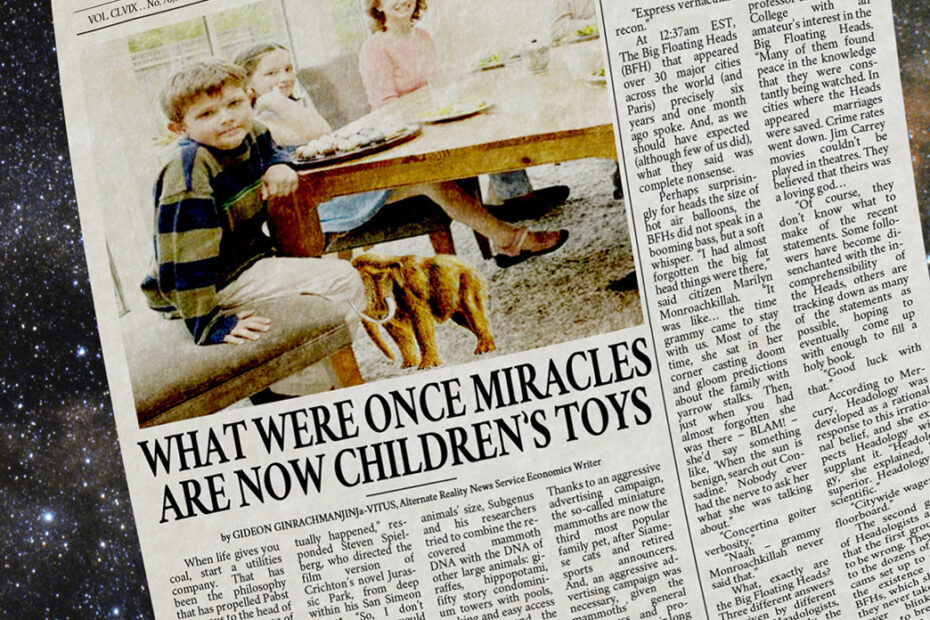by NANCY GONGLIKWANYEOHEEEEEEEH, Alternate Reality News Service Technology Writer
David Axelrod, who had spent several weeks working on a paper on soil erosion inside volcanoes for the Swedish government’s Ministry of Very, Very Hot Things, went home one evening believing that, with one final polish, he would change the country’s environmental policies forever. Or, at the very least, volcano deserts. Imagine his surprise when he arrived at his office the next day and found that the file contained, not the results of his earth-shattering investigation, but an imitation of a Jackson Pollock painting.
“And, not a very good one, at that,” Axelrod analyzed. “The lines were timid, very unlike the bold strokes that we expect from Pollock, and the colours were muted. It was very disappointing. I mean, if I have to lose three years worth of work, I at least want it to be for art.”
As it happened, Axelrod hadn’t lost his work. It had simply been transformed. This is the basis for the new business model known as C3 computing: cloud cuckoo computing…uhh…computing. The Swedish government rents space on a private company’s server. In addition to its stored files, the server also gives employees of organizations who are licenced to use it access to a variety of computer applications.
Big deal, right? Everybody from Microsoft to that 13 year-old son of Yugoslavian immigrants who lives three doors down and likes to be known as “LadeeKilla” runs computing clouds. What’s different about C3 computing?
“That’s a very good question,” replied Vernor Gesundheit, Chief Technology Officer of CressVexTech, a wholly owned subsidiary of MultiNatCorp, and one of the leaders (read: the only practitioner/proponent) of cloud cuckoo computing computing. Unfortunately, his answer lasted 25 minutes, took up six and a third white boards and was so dense steelmakers are afraid it could be used to make skyscrapers.
Translated into English, the explanation of the technology is this: a file on the server is chosen. The computer running the cloud then determines a random number between 547 and 12,627. It uses this number to count the files opened since the first one; the data from this file is used as the basis for a work of art in a different format. A word processing file, for example, may be turned into a sound file, a spreadsheet might be turned into an image, and so on. Greenwash, rinse, repeat.
Traditional C2 (cloud computing) computing gives businesses and governments the flexibility of having access to computer storage and applications without having to go to the trouble (read: expense) of having computers or anybody on staff who can actually run applications. The benefits should be obvious. Well, they’re obvious to anybody with an MBA.
Why, however, would any company want to use C3 computing for – okay, look, we know that this term is bad English. We know that the word “computing” is unnecessarily repeated. However, it is state of the art in the industry, and we don’t feel like lecturing Steve Jobs about good grammar, okay?
Why (because of our digression, it’s a paragraph later, so we’ve dropped the “however” because it has lost the connection to its referent) would any company want to use C3 computing for its sensitive data? “I have a very good answer to that,” Gesundheit claimed. “Will you print it if I manage to express it in…two and a half whiteboards?”
While we negotiate the length and complexity of Gesundheit’s answer, let us give a different but likely related answer: working in corporate bureaucracies can be soul-deadening. Employees with no souls are unlikely to be sources of innovation. By randomly turning files into works of art, CressVexTech brings enchantment back into the workplace, increasing efficiency and innovation.
“It’s brilliant!” Intel CTO Carl Rorschach enthused (read: he can afford the dry cleaning bills). “The information isn’t lost, just changed, so you can get the data back. One time, it took half our programmers half a day to turn a series of haiku back into the specs for a new chip – when we all recovered from our half-hearted heart attacks, we were refreshed and productivity soared!”
The technique has its critics, however. “Who in their right mind,” asked Stanley Mildew, CTO of the Wataskawin Public School Board, “would give some monolithic corporation access to all of their sensitive data, knowing how easy it would be for them to interfere with it for their own purposes?”
“Oh,” Rorschach responded. “Good…point. Let me, uhh, speak to my board and get back to you…”


